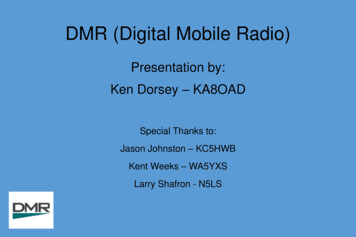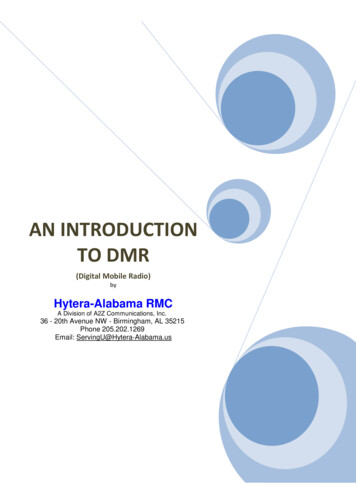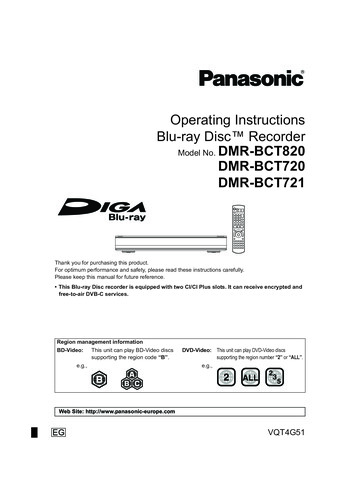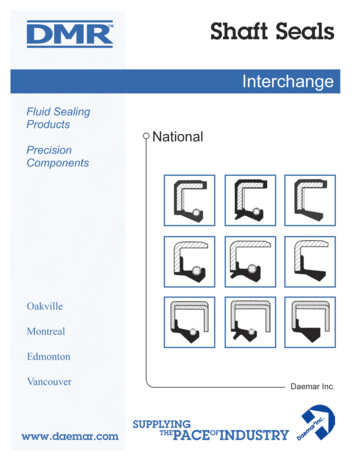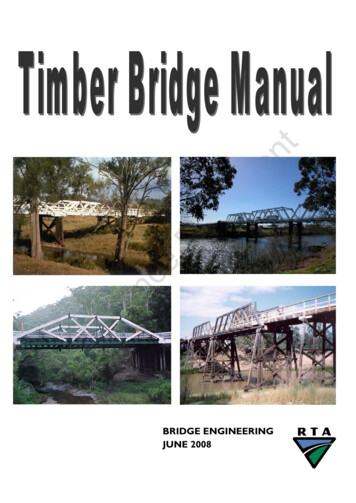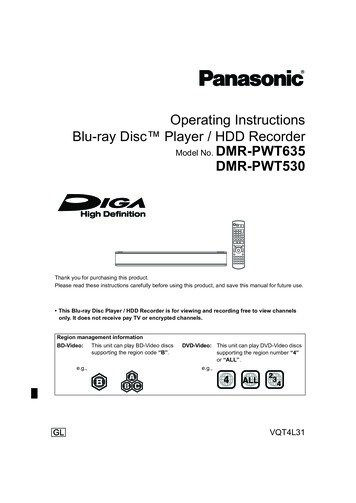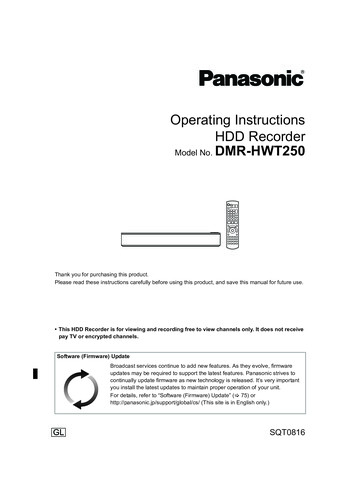
Transcription
The DMR Basics &No Frills What is DMR?Digital vs. AnalogTime Slots [TDMA] & Talk GroupsZonesColor CodesCode PlugsScanning and RoamingSimplexAdmit CriteriaRepeater AccessBasic Programming
DMR for DUMMIESDigital Mobile Radio (DMR) was developed by the European Telecommunications StandardsInstitute (ETSI) and is used worldwide by professional mobile radio users.[http://www.dmrassociation.org]DMR is divided into three tiers. Tier I is a single channel specification originally for the European unlicensed dPMR446 service. Itis a single channel FDMA 6.25 kHz bandwidth; the standard supports peer-to-peer (mode 1),repeater (mode 2) and linked repeater (mode 3) configurations. The use of the Tier I standard hasbeen expanded into radios for use in other than the unlicensed dPMR446 service.[http://www.dpmr-mou.org] Tier II is 2-slot TDMA 12.5 kHz wide peer-to-peer and repeater mode specification, resulting in aspectrum efficiency of 6.25 kHz per channel. Each time slot can be either voice and/or datadepending upon system needs. IP Site Connect (IPSC) for interconnecting repeaters over theInternet is vendor specific and is not part of the ETSI standards at this time. Most amateur radioimplementations of DMR are using voice on both time slots. Tier III builds upon Tier II, adding trunking operation involving multiple repeaters at a single site.Not all manufacturers’ trunking implementation is Tier III compatible. Vender specific protocolshave expanded the trunking to multiple site operations.
DMR for DUMMIESDigital vs. Analog If you are use to operating on analog FM repeaters, you will have noticed that the audio quality degrades asa station’s signal into the repeater (uplink) gets weaker; you start hearing an increase in noise burstsintermixed with the audio until the signal gets so weak that the station can no long access the repeater oryou can not understand the audio because of noise. As you move further from the repeater you will starthearing the same noise bursts into your receiver as the repeater’s signal gets weaker (downlink) until youcan no longer hear the repeater. A combination of a station’s weak signal into a repeater and a repeater’sweak signal to the listener can make the usability degrade faster. The basic difference with digital repeaters is that the audio quality remains the same on the uplink anddownlink until the very end of the coverage range; then the audio starts sounding broken (missingportions of the speech) on DMR systems caused by lost packets. The Internet can also drop the UDPpackets used for moving traffic between repeaters and bridges, causing the same broken audio affect.Analog static is a thing of the past using DMR. DMR has Forward Error Correction (FEC) which can correct small bit errors, slightly extending the usablerange and improving communication quality. Better quality receivers can operate at a lower noise floor, higher power transmitters, and higher gainantenna systems will also extend coverage of both analog and digital systems.
DMR for DUMMIESTwo-Slot TDMA DMR Tier II/Tier III occupies a 12.5 kHz bandwidth thattwo channels share using Time-Division Multiple Access(TDMA). This results in spectrum efficiency of 6.25 kHz perchannel. Comparing the spectrum efficiency of DMR to awideband analog FM, DMR only uses 25% of thebandwidth per talk channel. Each channel can carry either voice and/or datadepending on system design. The two time slots arecalled Time Slot 1 (TS1) and Time Slot 2 (TS2).fc - 12.5fcfc 12.5Wideband Analog FM25 kHz ChannelBandwidth(25 kHz per Channel)fc – 6.25 fc fc 6.25DMR12.5 kHz ChannelBandwidth(6.25 kHz per Channel)
DMR for DUMMIESTalk Groups Talk Groups (TG) are a way for groups of users to share a time slot (one to-many) withoutdistracting and disrupting other users of the time slot. It should be noted that only one TalkGroup can be using a time slot at a time. If your radio is not programmed to listen to a Talk Group,you will not hear that Talk Group’s traffic. The DMR-MARC Mototrbo network supports three Talk Groups on TS1; World Wide (TG1, PTT),North America (TG3), and World Wide English (TG13). TS2 is for Local (TG2), state (TG3112), andregional(TG33174) Talk Groups [http://www.dmr-marc.net/TG.html]. The DCI/TRBO networkuses TG3163 for North America and TG3161 for World Wide, and TG3 for World Wide English onTS2 [http://trbo.info/dci/talkgroups/index.html]. Check with your local repeater operator to findout what Talk Groups are available on its repeater. The DMR standard also supports private calls (one-to-one), encryption, and data. Private calls arenot allowed by most of the amateur networks and many consider private calls not amateurfriendly; private calls tie up a large number of repeater time slots across the network. Encryptionis not legal on amateur radio! Data and text messaging is supported on some networks.
DMR for DUMMIESTalk Groups (continued) For simplex traffic, the accepted standard in the amateur community is to use TG99 on TS1 with CC1. When programming your DMR radio, you may find it easier to program multiple Talk Groups for receive. Ihave two RX Group lists programmed in my radios, one for TS1 and one for TS2; this allows my radio tolisten to all the possible Talk Groups used on a time slot when I have my radio set to any channel. There are Talk Groups implemented for individual states and regional on many networks. Some Talk Groupsare available all the time, while others only at preprogrammed times. Some Talk Groups require a local 6user to PTT on the Talk Group to activate it for a period of time. Since only one Talk Group can be active at atime on a time slot, many systems will disable other Talk Groups when a local user is active on a differentTalk Group on the time slot. Be ham friendly and try to use Talk Groups that tie up the fewest number ofrepeaters if you are going to have a long QSO. Further information about specific Talk Groups can be foundon the DMR-MARC, DCI, and regional group p://ecs.orghttp://eqdmrmap.com
DMR for DUMMIESGroup ContactsPrivate Contacts1WWWorld Wide3112249 KG4FUR GerryBoca RatonFLUSA2LOLocal Network7400002 HC2GBT GerryGuyaquilGuayasECU3NANorth America9LRLocal Repeater13ENWorld Wide English14SPWorld Wide Spanish310TAC 310311TAC 3113112 FLFL Statewide3174 SESE USA16777215 ACAll CallISIM ID Key (Mobile Country Code (MCC))xxxyzzz User (7 digit)2 Europexxxyzz Repeater (6 digit)3 North America4 Asia, Middle Eastx Country5 Oceanay State/Province6 Africaz Sequence7 South/Central America
DMR for DUMMIEShttp://www.dmr-marc.nethttp://dmr-ecs.org
DMR for DUMMIESZones User DMR radios support Zones. A Zone is just a grouping of individual channels.Some model radios may limit the number of channels per Zone and the numberof Zones allowed. TYT and CS limit is 16 channels per Zone. You could program Zones for local channels (DMR or analog), another Zone for aneighboring state, and a Zone for business and government channels. If you doprogram non-amateur channels in your radio, make sure they are RX only unlessyou are licensed or authorized to use them as per FCC 90.427(b); otherwise youwill be in violation of FCC R&Rs and enforcement action could be taken againstyou. If you have a VHF model, you could program a Zone for all the possible NWSWeather Channels (again, make sure you program the channels as receive only). Zones are just a way to manage large number of channels, much like file foldersor directories on your computer. You may want to equate Zones with Repeaters.
DMR for DUMMIESColor Codes DMR repeaters use Color Codes (CC) much like analog repeaters useCTCSS (PL) or DCS. To access a repeater you must program your radio touse the same CC as the repeater. There are 16 different CCs (CC0-CC15). The use of Color Codes is not optional on DMR systems. If your Color Codeis not set correctly, you will not be able to access the repeater. The only real purpose of using different Color Codes is when multiplerepeaters operating on the same frequency have overlapping coverageareas. Note: CC1 is most often used in Florida.
DMR for DUMMIESCode Plugs A code plug is simply a radio’s configuration file. Using a manufacturer’s programming software you configure the channels andoperating parameters of a radio. This file is uploaded to the radio and typicallyshould also be saved on you computer as a backup. You can also download thecode plug from a radio to modify it. Building a code plug can take many hours, especially if you want to programhundreds of channels. The code plug can also contain a Contact List of Radio IDs, call signs, and namesto be displayed. You can find copies of configured code plugs on the web fordifferent models of radio; check out the different Yahoo DMR groups. All DMRradios support a limited number of entries in the Contact List; you can downloadCode Plugs with the Contact List populated using a generator on the DMR-MARChome.
DMR for DUMMIESScanning All DMR radios allow you to configure scanning of channels. Remember, you will only hear traffic on the frequency, time slot, andgroups you have programmed on a channel. Typically you scan both time slots on my local repeater and a simplexchannel. You can also scan analog channels mixed with the digital channels. Scanning will decrease the battery life on your radio.
DMR for DUMMIESRoaming Roaming is not supported on all DMR radios. Check your owner’s manual or manufacturerwebsite to see if roaming is supported. In some radios it may be an additional cost option. Roaming is NOT scanning. Roaming is similar but different. Roaming is designed to have yourradio automatically select the best channel if your current channel’s Receive Signal StrengthIndicator (RSSI) falls below a defined level as you move throughout the coverage area of agroup of repeaters that carry the same Talk Groups on the same time slots. You should selectchannels that have the same time slot and receive groups configured; if you do not, roaming maynot work correctly. Repeaters can be configured to transmit beacons at predefined intervals ofinactivity so roamers will be on the correct channel. Without the repeater beacons, roaming willstill work, but the radio will only change channels if it hears a repeater on the air. Roaming would be really great if all the DMR repeaters were on the same set of repeater pairsacross the country, but it is too much to expect the Repeater Councils to work together for aunified rebanding of existing coordinations. It would also help if the different DMR networkscould agree on which time slots were used by which Talk Groups, on the same time slots in yourradio and be able to travel across North America and be able to access all DMR repeaters?
DMR for DUMMIESSimplex On the professional side of DMR, Talk-Around refers to operating simplex on a repeater output channel.This allows a direct communication while still being able to hear the repeater. This allows users to directlycontact other users listening on the repeater output frequency. Amateurs typically use dedicated simplexchannels so as not to interfere with repeaters. The amateur DMR community has published a list ofrecommended simplex frequencies to be used instead of operating simplex on repeater outputs:UHF 1) 441.000 2) 446.500 3) 446.075 4) 433.450VHF 1) 145.790 2) 145.510 [Use TG99 / CC1 / TS1 /Admit Criteria: Always / In Call Criteria: TX or Always] Do not use 146.520 or 446.000; they are the national analog simplex channels and operating DMR on thesecommon analog use frequencies will just cause disharmony within the amateur community. Also, avoidrepeater inputs and outputs, locally used non-DMR simplex channels, satellite sub-bands, and any otherfrequencies that could disrupt other amateur communications.
DMR for DUMMIESAdmit Criteria The Admit Criteria determines when your radio is allowed to transmit. The recommended setting for DMR repeater channels is Color CodeFree; this configures your radio to be polite to your own digitalsystem. You should configure your In Call Criteria to Follow AdmitCriteria. Simplex channels should be configured as Always for both AdmitCriteria and Always or Follow TX for In Call Criteria. Analog repeater channels should be configured as Channel Free
DMR for DUMMIESAccessing a DMR Repeater When you want to access a DMR repeater, you must have the frequency, ColorCode, and Talk Group set correctly. When you key your transceiver, you send asignal to the repeater and the repeater responds back to you to acknowledge youcan transmit your message. If you do not receive the repeater’sacknowledgement, your radio will stop transmitting and you will hear a negativeconfirmation tone. This is one of the advantages of TDMA: allowing bidirectionalcommunications between user and the repeater when transmitting. The repeatercan also signal your radio to stop transmitting if there is contention on thenetwork because more than one station is transmitting at a time. Not all DMR repeaters are interconnected on the Internet. Internet connectivitymay not be available at the repeater site, or not available at a reasonable cost.Some repeater operators may just prefer to keep their repeater for local usageonly, or maybe only want it connected to a small local/regional network, withoutconnecting to the larger world wide networks.
DMR for DUMMIESAnalogDMR (Digital Mobile Radio) Frequency Pair (440 5.0 offset) 25.0 kHz Bandwidth Frequency Pair (440 5.0 offset) TDM 12.5 kHz: 1 full bandwidth slot - Repeater Sub Auditable Tones [CTSCC (PL) or DCS] Program/Configuration File 2 Time Slots [TS1, TS2] Talk Groups [TG] Group Contacts Private Calls All Call ZonesColor Codes [CC0-CC15]Code PlugAdmit Criteria Color Code Always Channel FreeDMRSimplexAnalog Programming your DMR Radio
DMR Programming for DUMMIESMD 380/390CS-750/8001.2.3.4.5.6.7.8.9.General Setting / SettingMenu Items / MenuButtons Definitions / ButtonsText Message / Text MessageDigital Contacts / ContactsDigital RX Groups / RX Group ListChannels Information / ChannelZone Information / ZoneScan List / Scan
DMR Programming for DUMMIESGeneral Settings Radio Name: your call sign Radio ID: your 7 digit DMR ID Intro Screen Line 1: your call signand name (up to10 digits) Intro Screen Line 2: your DMR IDor name
DMR Programming for DUMMIESMenu Items Verify checked items
DMR Programming for DUMMIESButtons Definitions Select Short/Long Press and SideButton settings These may vary by personalpreference Note: CS 750/800 have moreoptions
DMR Programming for DUMMIESText Message Personal Selection
DMR Programming for DUMMIES
DMR Programming for DUMMIESDigital RX Groups You need one for everyTalk Group You may combine TalkGroups under on RXGroup List. See DMR GA IL IN MI
DMR Programming for DUMMIESChannels InformationDigital Analog Data-1st Column Channel Mode (digi/analog) Band Width (12.5 or 25.0) Scan List Power (hi/lo)Analog Data CTCSS/DCS Dec/Enc
DMR Programming for DUMMIESChannels InformationDigital Analog Data-2nd Column Channel Name (DLB DMR ) RX Freq (443.30000) TX Freq (448.30000) Admit Code (Always/ChannelFree/Color Code) Allow Talkaround (onrepeaters only)
DMR Programming for DUMMIESChannels InformationDigital Analog Data-3rd Column Contact Name(DMR ) Group List (DMR ) Color Code (0-15) Repeater Slot (1-2)
DMR Programming for DUMMIESZone Information Zone Name Up to 16 Channels perZone Non Active Channelsindicated by: * MD 380/390 X CS 750/800
DMR Programming for DUMMIESScan Scan List Name Not limited 16Channels per List Priority Channelsare Optional
DMR Programming for DUMMIESRemember to Save your Work by either: File Save Save as Selecting the Floppy Disk SaveOtherwise your work will not be saved
code plug from a radio to modify it. Building a code plug can take many hours, especially if you want to program hundreds of channels. The code plug can also contain a Contact List of Radio IDs, call signs, and names to be displayed. You can find copies of configured code plugs on the web for



